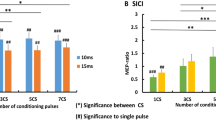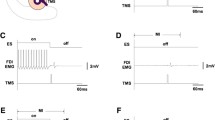Abstract
It has been shown that high-frequency repetitive transcranial magnetic stimulation (rTMS) to the human primary motor hand area (M1-HAND) can induce a lasting increase in corticospinal excitability. Here we recorded motor evoked potentials (MEPs) from the right first dorsal interosseus muscle to investigate how sub-threshold high-frequency rTMS to the M1-HAND modulates cortical and spinal excitability. In a first experiment, we gave 1500 stimuli of 5 Hz rTMS. At an intensity of 90% of active motor threshold, rTMS produced no effect on MEP amplitude at rest. Increasing the intensity to 90% of resting motor threshold (RMT), rTMS produced an increase in MEP amplitude. This facilitatory effect gradually built up during the course of rTMS, reaching significance after the administration of 900 stimuli. In a second experiment, MEPs were elicited during tonic contraction using weak anodal electrical or magnetic test stimuli. 1500 (but not 600) conditioning stimuli at 90% of RMT induced a facilitation of MEPs in the contracting FDI muscle. In a third experiment, 600 conditioning stimuli were given at 90% of RMT to the M1-HAND. Using two well-established conditioning-test paradigms, we found a decrease in short-latency intracortical inhibition (SICI), and a facilitation of the first peak of facilitatory I-waves interaction (SICF). There was no correlation between the relative changes in SICI and SICF. These results demonstrate that subthreshold 5 Hz rTMS can induce lasting changes in specific neuronal subpopulations in the human corticospinal motor system, depending on the intensity and duration of rTMS. Short 5 Hz rTMS (600 stimuli) at 90% of RMT can selectively shape the excitability of distinct intracortical circuits, whereas prolonged 5 Hz rTMS (≥900 stimuli) provokes an overall increase in excitability of the corticospinal output system, including spinal motoneurones.





Similar content being viewed by others
References
Chen R, Classen J, Gerloff G, Celnik P, Wassermann EM, Hallett M, Cohen LG (1997) Depression of motor cortex excitability by low frequency transcranial magnetic stimulation. Neurology 48:1398–1403
Day BL, Dressler D, Maertens de Noordhout A, Marsden CD, Nakashima K, Rothwell JC, Thompson PD (1989) Electric and magnetic stimulation of human motor cortex: surface EMG and single motor unit responses. J Physiol 412:449–473
Di Lazzaro V, Oliviero A, Profice P, Saturno E, Pilato F, Insola A, Mazzone P, Tonali P, Rothwell JC (1998) Comparison of descending volleys evoked by transcranial magnetic and electric stimulation in conscious humans. Electroen Clin Neuro 109:397–401
Di Lazzaro V, Oliviero A, Profice P, Insola A, Mazzone P, Tonali P, Rothwell JC (1999) Direct recordings of descending volleys after transcranial magnetic and electric motor cortex stimulation in conscious humans. Electroen Clin Neuro Suppl 51:120–126
Di Lazzaro V, Oliviero A, Mazzone P, Pilato F, Saturno E, Dileone M, Insola A, Tonali PA, Rothwell JC (2002) Short-term reduction of intracortical inhibition in the human motor cortex induced by repetitive transcranial magnetic stimulation. Exp Brain Res 147:108–113
Fitzgerald PB, Brown TL, Daskalakis ZJ, Chen R, Kulkarni J (2002) Intensity-dependent effects of 1 Hz rTMS on human corticospinal excitability. Clin Neurophysiol 113:1136–1141
Gangitano M, Valero-Cabre A, Tormos JM, Mottaghy FM, Romero JR, Pascual-Leone A (2002) Modulation of input-output curves by low and high frequency repetitive transcranial magnetic stimulation of the motor cortex. Clin Neurophysiol 113:1249–1257
Gerschlager W, Siebner HR, Rothwell JC (2001) Decreased corticospinal excitability after subthreshold 1 Hz rTMS over lateral premotor cortex. Neurology 57:379–380
Hallett M (2000) Transcranial magnetic stimulation and the human brain. Nature 6792:147–150
Kujirai T, Caramia MD, Rothwell JC, Day BL, Thompson PD, Ferbert A, Wroe S, Asselman P, Marsden CD (1993) Corticocortical inhibition in human motor cortex. J Physiol 471:501–519
Maeda F, Keenan JP, Tormos JM, Topka H, Pascual-Leone A (2000a) Modulation of corticospinal excitability by repetitive transcranial magnetic stimulation. Clin Neurophysiol 111:800–805
Maeda F, Keenan JP, Tormos JM, Topka H, Pascual-Leone A (2000b) Interindividual variability of the modulatory effects of repetitive transcranial magnetic stimulation on cortical excitability. Exp Brain Res 133:425–430
Modugno N, Nakamura Y, MacKinnon CD, Filipovic SR, Bestmann S, Berardelli A, Rothwell JC (2001) Motor cortex excitability following short trains of repetitive magnetic stimuli. Exp Brain Res 140:453–459
Muellbacher W, Ziemann U, Boroojerdi B, Hallett M (2000) Effects of low-frequency transcranial magnetic stimulation on motor excitability and basic motor behavior. Clin Neurophysiol 111:1002–1007
Oldfield RC (1971) The assessment and analysis of handedness: the Edinburgh inventory. Neuropsychologia 9:97–113
Pascual-Leone A, Valls-Sole J, Wassermann EM, Hallett M (1994) Responses to rapid-rate transcranial magnetic stimulation of the human motor cortex. Brain 117:847–858
Pascual-Leone A, Tormos JM, Keenan J, Tarazona F, Canete C, Catala MD (1998) Study and modulation of human cortical excitability with transcranial magnetic stimulation. J Clin Neurophysiol 15:333–343
Peinemann A, Lehner C, Mentschel C, Munchau A, Conrad B, Siebner HR (2000) Subthreshold 5-Hz repetitive transcranial magnetic stimulation of the human primary motor cortex reduces intracortical paired-pulse inhibition. Neurosci Lett 296:21–24
Peinemann A, Reimer B, Löer C, Quartarone A, Münchau A, Conrad B, Siebner HR (2004) Long-lasting increase in corticospinal excitability after 1800 pulses of subthreshold 5 Hz repetitive TMS to the motor cortex. Clin Neurophysiol 115(7):1519–26
Rizzo V, Siebner H, Modugno N, Pesenti A, Munchau A, Gerschlager W, Webb RM, Rothwell JC (2004) Shaping the excitability of human motor cortex with premotor rTMS. J Physiol 554:483–495
Romero JR, Anschel D, Sparing R, Gangitano M, Pascual-Leone A (2002) Subthreshold low frequency repetitive transcranial magnetic stimulation selectively decreases facilitation in the motor cortex. Clin Neurophysiol 113:101–107
Rossini PM, Barker AT, Berardelli A, Caramia MD, Caruso G, Cracco RQ, Dimitrijevic MR, Hallett M, Katayama Y, Lucking CH (1994) Non-invasive electrical and magnetic stimulation of the brain, spinal cord and roots: basic principles and procedures for routine clinical application. Report of an IFCN committee. Electroen Clin Neuro 91:79–92
Rothwell JC (1997) Techniques and mechanisms of action of transcranial stimulation of the human motor cortex. J Neurosci Meth 74:113–122
Rothwell JC (1999) Paired-pulse investigations of short-latency intracortical facilitation using TMS in humans. Electroen Clin Neuro Suppl 51:113–119
Rounis E, Siebner HR, et al (2003) The effect of 5 Hz repetitive transcranial magnetic stimulation over the left primary motor hand area on regional blood flow and motor cortex excitability. NeuroImage 19:17822 (available on CD-Rom in Issue 2, Suppl 1)
Siebner HR, Rothwell J (2003) Transcranial magnetic stimulation: new insights into representational cortical plasticity. Exp Brain Res 148:1–16
Siebner HR, Peller M, Willoch F, Minoshima S, Boecker H, Auer C, Drzezga A, Conrad B, Bartenstein P (2000) Lasting cortical activation after repetitive TMS of the motor cortex: a glucose metabolic study. Neurology 54:956–963
Siebner HR, Takano B, Peinemann A, Schwaiger M, Conrad B, Drzezga A (2001) Continuous transcranial magnetic stimulation during positron emission tomography: a suitable tool for imaging regional excitability of the human cortex. NeuroImage 14:883–890
Sommer M, Wu T, Tergau F, Paulus W (2002) Intra- and interindividual variability of motor responses to repetitive transcranial magnetic stimulation. Clin Neurophysiol 113:265–269
Tokimura H, Ridding MC, Tokimura Y, Amassian VE, Rothwell JC (1996) Short latency facilitation between pairs of threshold magnetic stimuli applied to human motor cortex. Electroen Clin Neuro 101:263–272
Touge T, Gerschlager W, Brown P, Rothwell JC (2001) Are the after effects of low-frequency rTMS on motor cortex excitability due to changes in the efficacy of cortical synapses? Clin Neurophysiol 112:2138–2145
Ugawa Y, Rothwell JC, Day BL, Thompson PD, Marsden CD (1991) Percutaneous electrical stimulation of corticospinal pathways at the level of the pyramidal decussation in humans. Ann Neurol 29:418–27
Valero-Cabre A, Oliveri M, Gangitano M, Pascual-Leone A (2001) Modulation of spinal cord excitability by subthreshold repetitive transcranial magnetic stimulation of the primary motor cortex in humans. Neuroreport 12:3845–3848
Wassermann EM (1998) Risk and safety of repetitive transcranial magnetic stimulation: report and suggested guidelines from the International Workshop on the Safety of Repetitive Transcranial Magnetic Stimulation, June 5–7, 1996. Electroen Clin Neuro 108:1–16
Wu T, Sommer M, Tergau F, Paulus W (2000) Lasting influence of repetitive transcranial magnetic stimulation on intracortical excitability in human subjects. Neurosci Lett 287:37–40
Ziemann U (1999) Intracortical inhibition and facilitation in the conventional paired TMS paradigm. Electroen Clin Neuro Suppl 51:127–136
Ziemann U, Lonnecker S, Steinhoff BJ, Paulus W (1996) Effects of antiepileptic drugs on motor cortex excitability in humans: a transcranial magnetic stimulation study. Ann Neurol 40:367–378
Ziemann U, Tergau F, Wassermann EM, Wischer S, Hildebrandt J, Paulus W (1998a) Demonstration of facilitatory I waves interaction in the human motor cortex by paired transcranial magnetic stimulation. J Physiol 511:181–190
Ziemann U, Tergau F, Wischer S, Hildebrandt J, Paulus W (1998b) Pharmacological control of facilitatory I-wave interaction in the human motor cortex. A paired transcranial magnetic stimulation study. Electroen Clin Neuro 109:321–330
Acknowledgements
H.R. Siebner was supported by the Bundesministerium für Bildung und Forschung (grant 01GO0206) and the Volkswagen Foundation (grant I/79 932).
Author information
Authors and Affiliations
Corresponding author
Rights and permissions
About this article
Cite this article
Quartarone, A., Bagnato, S., Rizzo, V. et al. Distinct changes in cortical and spinal excitability following high-frequency repetitive TMS to the human motor cortex. Exp Brain Res 161, 114–124 (2005). https://doi.org/10.1007/s00221-004-2052-5
Received:
Accepted:
Published:
Issue Date:
DOI: https://doi.org/10.1007/s00221-004-2052-5




